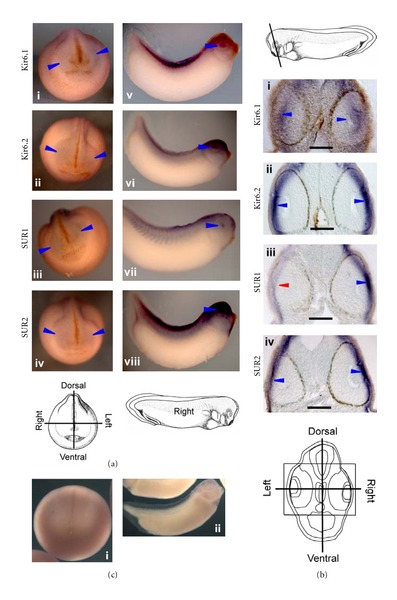Figure 3.

KATP channels are expressed in the putative eye regions and in the eye tissue in a left-right asymmetric manner. (a) Xenopus embryos at stage 18 (i)–(iv) and stage 30 (v)–(viii) were analyzed by in situ hybridization for KATP channel subunits showing their presence in the putative eye region ((i)–(iv) blue arrowheads) as well as in differentiated eye tissue ((v)–(viii) blue arrowheads). All four subunits (Kir6.1, Kir6.2, SUR1, and SUR2) were found to be present in the putative and developed eye tissue. In addition to the eye tissue, the KATP channel subunits were also present in the general head region and the dorsal region of the trunk. Illustration shows a stage 18 embryo with the dorsal-ventral and the left-right axes. (b) Transverse JB4 sections of in situ hybridized Xenopus embryos at stage 30 (i)–(iv) showing left-right distribution of the KATP channel subunits. Illustration shows the plane of sectioning of the stage 30 embryo. Kir6.1 expression is found in the inner retinal part of the eye vesicle ((i) blue arrowheads) and in the brain especially in the cells lining the ventricle and in some cells surrounding the eye tissue. Kir6.2, SUR1, and SUR2 expression is found in the inner layer of the 2-layer epidermis with intense staining at the lens placode ((ii)–(iv) blue arrowheads). Kir6.1, Kir6.2, and SUR2 expression is symmetric ((i), (ii), and (iv) blue arrowheads). SUR1 shows asymmetric distribution ((iii) red and blue arrowheads) where red arrowheads indicate the side with lessened expression. Scale bars = 100 μm. Schematic shows a transverse section of a stage 30 embryo with the dorsal-ventral and the left-right axes indicated. (c) Sense probes showed no signal detected at neurula (i) or tailbud (ii) stages.
